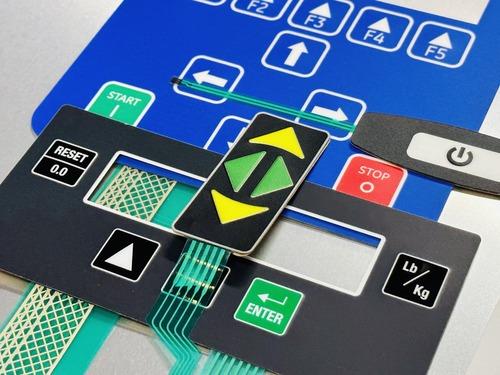How Membrane Switches Are Designed for Easy Maintenance and Repair
How Membrane Switches Are Designed for Easy Maintenance and Repair
Blog Article
Understanding the Value of Membrane Switches in Customer Interfaces
Membrane switches are indispensable components in the style of reliable customer interfaces, helping with not only performance yet also enhancing aesthetic charm and customer communication. As we discover the various advantages and future patterns linked with Membrane modern technology, it becomes clear that these switches are much more than just elements; they represent a merging of advancement and usefulness.
What Are Membrane Buttons?

The spacer layer, which includes adhesive residential or commercial properties, allows for the separation of the circuit layer from the overlay, guaranteeing that the switch continues to be in a non-activated state up until pressed. When pressure is used to the overlay, it presses the spacer layer, connecting the gap and finishing the circuit in the underlying layer. This style not only reduces the physical space needed for typical mechanical buttons but also boosts the toughness of the gadget, as Membrane buttons are normally resistant to dust, dampness, and other environmental variables.
Frequently discovered in applications ranging from customer electronic devices to medical tools, Membrane switches are integral to modern-day innovation, providing a easy to use and efficient user interface that lines up with contemporary design demands.
Advantages of Membrane Switches
While many button technologies exist, Membrane Switches deal distinct advantages that make them specifically desirable in numerous applications. One of the main advantages of Membrane switches is their portable design, which permits space-saving executions in devices where realty is restricted. Their slim profile not just boosts aesthetic charm yet also helps with light-weight construction.
Another considerable benefit is their resistance to environmental elements. Membrane buttons are typically sealed versus dampness, dust, and contaminants, making them suitable for usage sought after environments, such as medical gadgets and commercial tools. This resilience prolongs the life expectancy of the button, lowering maintenance costs and enhancing dependability.
In addition, Membrane buttons can be tailored to meet specific style demands, integrating one-of-a-kind graphics and shades that boost customer communication. Their responsive feedback options can also be customized to provide a rewarding user experience. Additionally, Membrane switches are cost-effective, particularly in high-volume applications, as they can be produced efficiently.
Applications in Various Industries

In the customer electronics sector, Membrane switches are prevalent in devices such as microwaves, cleaning makers, and push-button controls. Their tactile responses and visual options boost customer experience while offering a smooth, modern appearance. Additionally, automotive suppliers use Membrane buttons in control panel controls and infotainment systems, where room is restricted, and user interaction is vital.
Furthermore, the commercial industry leverages Membrane buttons in control panels for machinery and tools, enabling intuitive procedure in commonly extreme settings. Their resistance to chemicals and wetness ensures durability and integrity in these applications. In general, the adaptability of Membrane Switches adds substantially to you can check here their prevalent use, making them crucial in different technical domains.
Style Considerations for Membrane Buttons

When creating Membrane buttons, numerous key considerations should be taken into account to make sure optimum capability and user experience. Firstly, the choice of materials is vital; choosing long lasting, high-quality substrates can enhance the switch's longevity and resistance to environmental elements such as wetness and temperature changes.
Secondly, the design of the graphic overlay should prioritize clarity and simplicity of usage. Symbols and text must be legible, and the layout ought to assist in instinctive interaction (membrane switches). Furthermore, tactile comments is vital; integrating a tactile dome or other devices can boost the customer experience by supplying physical confirmation of activation
One more essential element is the switch's electric efficiency. Designers should ensure that the conductive traces are properly designed to decrease resistance and prevent signal interference. This involves assessing the called for actuation force and guaranteeing compatibility with the electronic parts they will certainly interface with.

Future Trends in Membrane Modern Technology
As innovation remains to development, Membrane switches are poised to advance substantially, driven by technologies in materials and making techniques. One emerging fad is the incorporation of sophisticated products, such as conductive inks and flexible substratums, which enhance longevity and reduce the general weight of Membrane buttons. These materials not only improve the tactile action yet also enable for the style of buttons that can withstand harsher environmental conditions.
Moreover, the assimilation of touch-sensitive technologies is transforming conventional Membrane Switches into even more interactive customer interfaces. Capacitive touch sensing units installed within Membrane switch panels can provide a more intuitive and responsive individual experience, straightening with the expanding need for streamlined, modern-day layouts in consumer electronics.
Additionally, developments in printing methods, such as digital and 3D printing, allow fast prototyping and personalization of Membrane switches. This versatility enables producers to respond much more swiftly to market demands description and consumer preferences.
Lastly, sustainability is becoming a significant focus, with manufacturers exploring environmentally friendly materials and processes. As these fads unravel, the future of Membrane innovation promises enhanced functionality, visual charm, and environmental responsibility, strengthening their role website here in innovative interface across various sectors.
Verdict
In final thought, Membrane Switches stand for a vital element in the layout of user interfaces, incorporating functionality with visual flexibility. As developments in modern technology continue, the advancement of Membrane switches is anticipated to more refine customer interfaces, driving innovation and enhancing use in an increasingly complicated technical landscape.
Membrane switches are important parts in the design of efficient customer interfaces, facilitating not just capability but also improving visual appeal and user interaction.Membrane Switches offer as an essential part in various individual interfaces, assisting in a smooth communication between users and electronic gadgets.While countless button technologies exist, Membrane Switches offer unique advantages that make them especially preferable in numerous applications.In addition, Membrane buttons can be customized to satisfy certain layout needs, including unique graphics and colors that improve individual communication.In verdict, Membrane Switches stand for an essential part in the design of customer interfaces, incorporating capability with visual adaptability.
Report this page